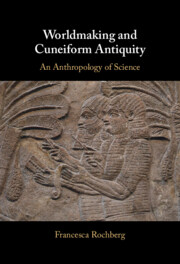Refine search
Actions for selected content:
13574 results in History of science and technology
Acknowledgments
-
- Book:
- Monopolizing Knowledge
- Published online:
- 02 January 2025
- Print publication:
- 16 January 2025, pp xi-xii
-
- Chapter
- Export citation
Bibliography
-
- Book:
- Monopolizing Knowledge
- Published online:
- 02 January 2025
- Print publication:
- 16 January 2025, pp 262-284
-
- Chapter
- Export citation
7 - The Commercializing Mission
- from Part II - From Company Science to Public Science, 1813–1858
-
- Book:
- Monopolizing Knowledge
- Published online:
- 02 January 2025
- Print publication:
- 16 January 2025, pp 212-256
-
- Chapter
- Export citation

Worldmaking and Cuneiform Antiquity
- An Anthropology of Science
-
- Published online:
- 09 January 2025
- Print publication:
- 09 January 2025
2 - Cuneiform Texts and the Historiography of Science
- from Part I - Historiography of Science
-
- Book:
- Worldmaking and Cuneiform Antiquity
- Published online:
- 09 January 2025
- Print publication:
- 09 January 2025, pp 53-79
-
- Chapter
- Export citation
1 - These Bones Live!
- from Part I - Historiography of Science
-
- Book:
- Worldmaking and Cuneiform Antiquity
- Published online:
- 09 January 2025
- Print publication:
- 09 January 2025, pp 31-52
-
- Chapter
- Export citation
Glossary of Astronomical Terminology Cited
-
- Book:
- Worldmaking and Cuneiform Antiquity
- Published online:
- 09 January 2025
- Print publication:
- 09 January 2025, pp xvii-xix
-
- Chapter
- Export citation
Part I - Historiography of Science
-
- Book:
- Worldmaking and Cuneiform Antiquity
- Published online:
- 09 January 2025
- Print publication:
- 09 January 2025, pp 29-102
-
- Chapter
- Export citation
Notes on Chronological and Typographical Conventions
-
- Book:
- Worldmaking and Cuneiform Antiquity
- Published online:
- 09 January 2025
- Print publication:
- 09 January 2025, pp xv-xvi
-
- Chapter
- Export citation
Dedication
-
- Book:
- Worldmaking and Cuneiform Antiquity
- Published online:
- 09 January 2025
- Print publication:
- 09 January 2025, pp v-v
-
- Chapter
- Export citation
Conclusion
- from Part II - Worldmaking and the Anthropology of Science
-
- Book:
- Worldmaking and Cuneiform Antiquity
- Published online:
- 09 January 2025
- Print publication:
- 09 January 2025, pp 212-214
-
- Chapter
- Export citation
4 - The Idea of Worlds
- from Part II - Worldmaking and the Anthropology of Science
-
- Book:
- Worldmaking and Cuneiform Antiquity
- Published online:
- 09 January 2025
- Print publication:
- 09 January 2025, pp 105-132
-
- Chapter
- Export citation
3 - The Early Shaping of a Modern Historiography of Ancient Astronomical Sciences
- from Part I - Historiography of Science
-
- Book:
- Worldmaking and Cuneiform Antiquity
- Published online:
- 09 January 2025
- Print publication:
- 09 January 2025, pp 80-102
-
- Chapter
- Export citation
Contents
-
- Book:
- Worldmaking and Cuneiform Antiquity
- Published online:
- 09 January 2025
- Print publication:
- 09 January 2025, pp vii-vii
-
- Chapter
- Export citation
Copyright page
-
- Book:
- Worldmaking and Cuneiform Antiquity
- Published online:
- 09 January 2025
- Print publication:
- 09 January 2025, pp iv-iv
-
- Chapter
- Export citation
References
-
- Book:
- Worldmaking and Cuneiform Antiquity
- Published online:
- 09 January 2025
- Print publication:
- 09 January 2025, pp 215-248
-
- Chapter
- Export citation
Epigraph
-
- Book:
- Worldmaking and Cuneiform Antiquity
- Published online:
- 09 January 2025
- Print publication:
- 09 January 2025, pp vi-vi
-
- Chapter
- Export citation
6 - Worldmaking in Cuneiform Culture
- from Part II - Worldmaking and the Anthropology of Science
-
- Book:
- Worldmaking and Cuneiform Antiquity
- Published online:
- 09 January 2025
- Print publication:
- 09 January 2025, pp 168-197
-
- Chapter
- Export citation
Abbreviations
-
- Book:
- Worldmaking and Cuneiform Antiquity
- Published online:
- 09 January 2025
- Print publication:
- 09 January 2025, pp xx-xxii
-
- Chapter
- Export citation
Preface
-
- Book:
- Worldmaking and Cuneiform Antiquity
- Published online:
- 09 January 2025
- Print publication:
- 09 January 2025, pp ix-xii
-
- Chapter
- Export citation
